“I’m Barack Obama, and I approved this message”…gangsta!
Year: 2012
Dumb Dog
I hung out yesterday with a little German mutt who was somewhat behind the eight ball. She came in barking, howling, scared, aggressive. All little dogs do this. So I tried to disarm things by sitting still, but she got upset whenever I got up or moved or eyeballed her. So I said “eff it” and pretended to be another dog — panting, mock-barking, making dog noises. Then I chased her around the room in a playful way. We gradually got down to the petting and stroking and “I’m okay, you’re okay” part. All was cool.
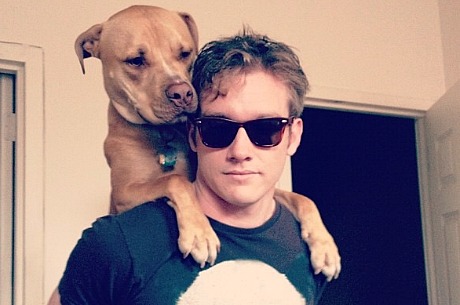
Joey is not the dumb dog of the title — he’s trusting, intelligent, very cool.
Then she went out for a walk and came back and was hyper and aggressive and yapping all over again. I could have been an alien from District 9. She didn’t remember a thing from before. All that bonding for nothing. Short-term memory loss. Then we went for a drive and she sat on my lap and I lightly massaged her neck and we were cool once again. But she had bad breath and farted and shed light-brown hair all over my black jeans and blue sweater. And then she got scared when I opened the window and moved her on my lap a bit and she bit me. I’ve gotten along with almost every dog I’ve ever met (including Joey, pictured above doing a Yoda-and-Luke thing with Jett) but not this one.
Another indication of dog stupidity is when they bark at planes flying overhead at 20,000 feet.
System
I’ve learned that it’s best to pack multiples of needed items on the theory that one or even two will be misplaced or lost or God forbid damaged before the journey ends. So I’ve got two Mac Powerbooks w/ cords and connectors for each, two digital cameras, four power adapters, four combs, four reading glasses, four sunglasses, four 3D glasses for glare reducation, etc. It’s not a theory, actually. Somehow and some way, losses (or to be more precise mystifying vanishings) always happen on trips. No preventing this and certainly no understanding why.
Measuring Stick
I’m amazed that someone believes that Walmart-frequenting Bluray obsessives will be even slightly interested in glancing at The Barbarian and the Geisha, easily one of John Wayne‘s worst films ever. “Before release, the film was heavily re-edited by the studio” and “director John Huston denounced this version and even wanted to have his name removed from the credits. Huston had wanted to make a particularly Japanese film in terms of photography, pacing, color and narration but only a few edits representing his vision were left intact.”
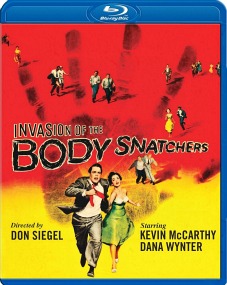

And how much better, really, can Don Siegel‘s Invasion of the Body Snatchers possibly look on Bluray? I know, I know — it’ll definitely look somewhat better but…oh, I give up. The distributors of this Bluray know that people like me are suckers for widescreen black-and-white. Blurays like this make me feel like a submissive dog.
Bluray Hitchbox
German Amazon has announced the year-end availability of a Universal/Alfred Hitchcock Bluray box set, which will street on 12.28. The titles will include Rope (meh), Rear Window (excellent!), The Man Who Knew Too Much (ditto), Torn Curtain (who cares?), The Birds (very good), Family Plot (meh), Frenzy (semi-okay), Shadow of a Doubt (excellent!), The Trouble with Harry (zzzz), Marnie (flatline), Psycho (already available), Saboteur (agreeable), Topaz (meh) and Vertigo (finally!). 14 films, 1607 minutes, 145.99 euros or 10.50 each.
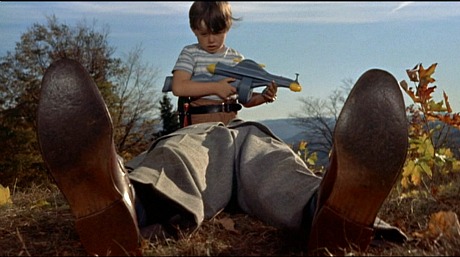
Known Quantities
Four days ago The Hollywood Reporter‘s Scott Roxborough posted an astute assessment of the likely favorings of the 2012 Cannes Film Festival jurors: actresses Hiam Abbass, Emmanuelle Devos and Diane Kruger, fashionista Jean Paul Gaultier, directors Alexander Payne, Andrea Arnold and Nanni Moretti, actor Ewan McGregor and documentarian and activist Raoul Peck.

Mother’s Day
I’m calling my mom later today via Skype. Skype to landline, I mean. But as usual, I’ll have to ask the people at her assisted living facility to make her pick up the phone. She never answers when I call directly, and she won’t call me on the cell. “Why don’t you answer when I call?,” I’ve asked. “Because I don’t feel like it,” she’s said more than once.
Toback-Baldwin Cannes Shoot
Sometime around last November’s Savannah Film Festival James Toback told me about a faux-documentary he was planning that would include lensing during the 2012 Cannes Film Festival. It’s since been reported that Alec Baldwin, Toback’s constant Savannah companion, will star as himself. Last week Forbes columnist Roger Friedman wrote that Toback’s film crew “will be hitting all the big [Cannes] parties and events” starting on Wednesday, and that Neve Campbell “shot some material for Toback in New York last week.”
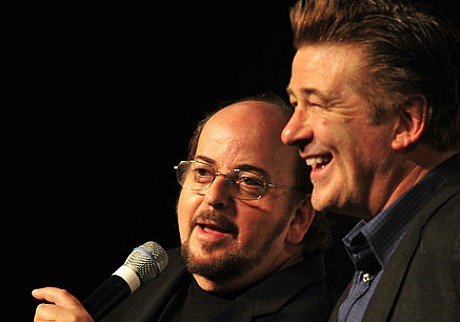
Berlin Wrap-Up
Today will include (a) a final burst (or slog) of Berlin-based column salt-mining, (b) a final three-mile walk this afternoon, (c) figuring out a bus departure point to Berlin Tegel tomorrow morning, (d) picking up dry cleaning, (e) re-packing, and (f) enjoying the anticipation of weather that’s actually warm and pleasant for a change. Expected Nice arrival Tuesday at 1:45 pm. Pick up press pass by 3:30 or 4 pm. La Pizza gathering at 7:30 pm.


Unacceptable
The more I think about it, the more I’m resenting the Cannes Film Festival’s decision to delay screening Jeff Nichols‘ Mud until Saturday, 5.26, at which point many if not most journos have left. That’s just obstinacy, provocation for provocation’s sake, etc. Publicists need to schedule a Star/Olympia screening a day or two earlier. Seriously.
“That Was Fast!”
A recently posted clip from Jacques Audiard‘s Rust & Bone, the much-anticipated 2012 Cannes Film Festival selection that costars Marion Cotillard and Matthias “big effing ape” Schoenaerts (the no-testicles Bullhead guy).
“Closer Than That, Walter”
The Masters of Cinema Bluray of Billy Wilder‘s Double Indemnity (1944), which I ordered weeks ago, will include an “extract” from the original screenplay depicting the excised gas chamber ending, which was filmed by Wilder but removed from the final version because it was deemed too depressing and “unduly gruesome.”
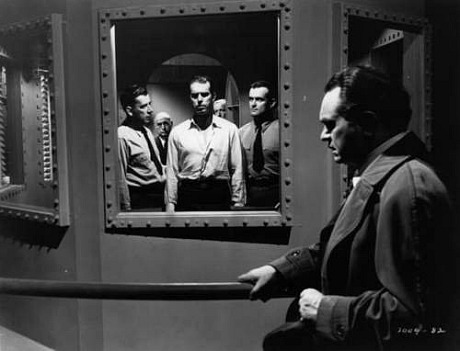
Consider this passage from filmsnoir.net: “In his 1998 book on film noir, More than Night: Film Noir in Its Contexts, James Naremore offers this penetrating analysis and critique:
“The execution described in the longest version of the script greatly increases our sympathy for Walter Neff (Fred MacMurray), all the while raising questions about the criminality of the state. It also provides a tragic recognition scene for Barton Keyes (Edward G. Robinson), who is shaken out of his moral complacency.
“This last point is especially important, because Keyes functions as a representative of the insurance company. Although he approaches his work with the intuitive flair of an artist and the intellectual intensity of a scientist, he remains a loyal agent of industrial rationality — a talented bureaucrat who, in effect, has helped to create the office building, the drive-in restaurant, the supermarket, and all the other landmarks of modern Los Angeles that the film relentlessly criticizes.
“One of the many virtues of Wilder’s original ending is that this complex, brilliantly acted character would have been made to confront his inner demon and to experience poetic justice. Keyes would have been brought face-to-face with the culminating instance of instrumental reason, the “end of the line” for industrial culture: the California gas chamber.
“For the original version of Double Indemnity, Paramount built an exact replica of San Quentin’s gas chamber, depicting it as a modern, sanitized apparatus for administering official death sentences. At considerable expense, Wilder photographed the step-by-step procedure of execution, emphasizing its coldly mechanical efficiency. There was no blood, no agonized screaming, and, for once in the movie, almost no dialogue.
“Much of the sequence was shot from Walter’s point of view, looking through glass windows at the spectators outside the chamber — an angle creating a subtle parallel between the chamber and the ‘dark room’ of a movie theater. When the fatal pellets dropped, clouds of gas obscured the windows, and we could barely make out Keyes standing amid the witnesses, turning his head away. Soon afterward, a doctor entered the chamber to pronounce Walter dead. According to the script, the original film ended as follows:
“‘All the witnesses have now left except Keyes, who stares, shocked and tragic, beyond the door. The guard goes to him and touches his arm, indicating to him that he must leave. Keyes glances for the last time towards the gas chamber and slowly moves to go out. CORRIDOR OUTSIDE THE DEATH CHAMBER CAMERA SHOOTING IN THROUGH THE OPEN DOOR AT KEYES , who is just turning to leave. Keyes comes slowly out into the dark, narrow corridor. His hat is on his head now, his overcoat is pulled around him loosely. He walks like an old man. He takes eight or ten steps, then mechanically reaches a cigar out of his vest pocket and puts it in his mouth. His hands, in the now familiar gesture, begin to pat his pockets for matches.
“‘Suddenly he stops, with a look of horror on his face. He stands rigid, pressing hand against his heart. He takes the cigar out of his mouth and goes slowly on toward the door, CAMERA PANNING with him. When he has almost reached the door, the guard stationed there throws it wide, and a blaze of sunlight comes in from the open prison yard outside. Keyes slowly walks out into the sunshine, a forlorn and lonely man.’
“Until someone rescues this scene from the Paramount vaults, we will never know if it is superior to the current version, and even then there may be room for debate. One thing, however, is clear: Keyes’s lonely walk out of the prison would have thrown a shadow over everything that preceded it. It was not until Sunset Boulevard and Ace in the Hole that Wilder would produce such a savage critique of modernity. Although the released version of his famous thriller remains an iconoclastic satire that challenges the censors, it is a lighter entertainment than the original and a much easier product for Hollywood to market.
“No matter how much we admire the film that was exhibited in 1944, the form of cinema that the French described as noir is probably better exemplified by another Double Indemnity, which we have yet to see.”
In a July 1975 Images Journal interview with Robert Porfirio, Wilder said the following:
“We were delighted with [the gas chamber ending] at first. Fred MacMurray loved it. He didn’t want to play it. No leading man wanted to play it, initially. But then he was absolutely delighted. I am a great friend of his, but can tell you when he shot the scene, there was no hesitation, no nothing, no problem with his performance. I shot that whole thing in the gas chamber, the execution, when everything was still, with tremendous accuracy.
“But then I realized, look, this thing is already over. I just already have one tag outside that office, when Neff collapses on the way to the elevator, where he can’t even light the match. And from the distance, you hear the sirens, be it an ambulance or be it the police, you know it is over. No need for the gas chamber.”
